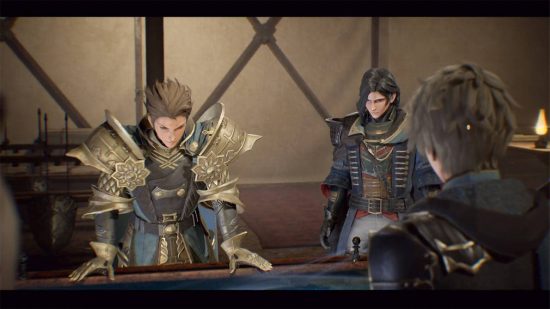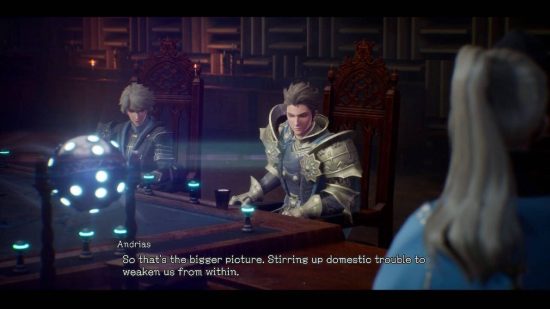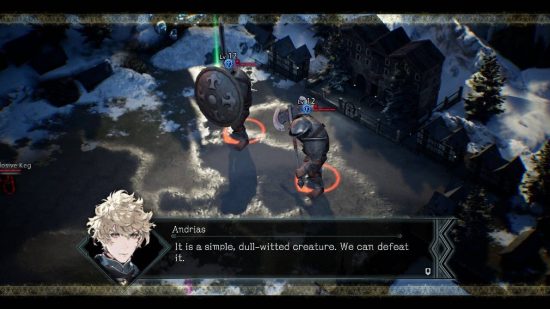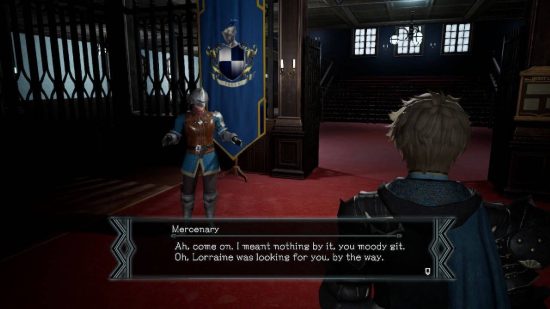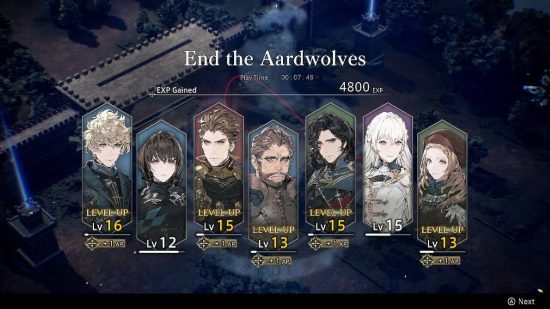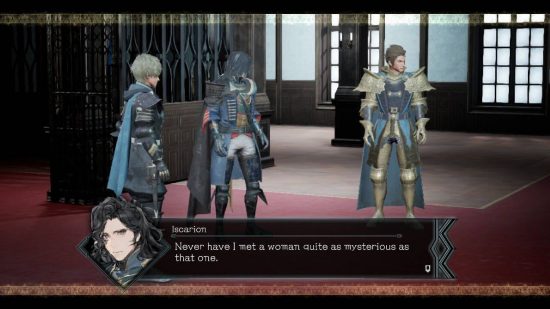Our Verdict
An impressive new franchise from Square Enix, The Diofield Chronicle has a thrilling real-time battle system that gives every moment a tense, and challenging twist. It’s incredibly satisfying to turn the tide of battle with well-calculated moves, and the high fantasy story is told well with interesting characters, great visuals, and a meticulously detailed story.
It seems that strategy RPG games are a lot like buses. You wait for ages for one to turn up, and then suddenly the station is absolutely jam-packed with them. While Switch owners already had the incredible Fire Emblem: Three Houses and Mario + Rabbids, this year has turned things up a notch with Triangle Strategy, Live A Live, a sequel to Mario + Rabbids incoming, Metal Slug Tactics en route, and even the recently announced Fire Emblem Engage.
So here comes The Diofield Chronicle, a new franchise from Square Enix staff member Shigeyuki Hirata, who people may know from the Ace Combat series, as a designer on Pokémon Mystery Dungeon: Explorer’s of the Sky, and as a scriptwriter on 999: Nine Hours · Nine Persons · Nine Doors. A varied resume but an interesting pedigree, and The Diofield Chronicle certainly feels like it makes use of talent.
If you’ve seen nothing so far, The Diofield Chronicle is a strategy RPG set on Diofield Island, a country rich with a powerful resource known as jade which is used for magic, and caught in between the warring nations of the Kingdom of Alletain and the Trovelt-Schoevian Empire. Well, that’s the cliff notes version, there are a lot more parties involved and the political branches of this story run surprisingly deep.
So far, if you simply swap jade for salt I could well be describing Square Enix’s other hit strategy RPG from 2022 called Triangle Strategy. I played and reviewed Triangle Strategy (and adored it), so in the build-up to The Diofield Chronicle, my worry wasn’t about the quality of the game, but simply how it would stand out. However, after getting my hands on the game, I’m happy to see that there are some major differences, and the biggest of those is in the gameplay.
Full disclosure, our code for The Diofield Chronicle only arrived on Friday, so while I did spend my weekend slamming through this game as quickly as I could, I simply haven’t had the time to complete it. I’ve certainly played enough to give an informed opinion, but for now, this is a review in progress, and I will update it later in the week as I continue the story and if my opinion on anything changes. But for now, I feel happy to share my thoughts so far.
The main selling point of The Diofield Chronicle is something Square Enix is calling the “real-time tactical battle” system, or RTTB. Many strategy games are entirely turn-based and on a large grid. Instead, TDC lets the action fold out in real-time, and the levels are large open areas with shortcuts and advantageous elements tucked away for players to discover. It’s an interesting twist and one that adds an exciting element of fear to battles, as you don’t always have the luxury of examining the whole board and moving your characters like a well-oiled game of chess.
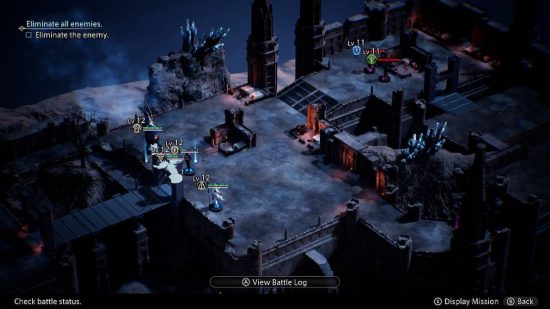
Instead, TDC feels to me more like a real war between armies. You must keep a sharp eye on the tide of battle, on the direction enemy units are approaching from, and constantly be moving your characters to make sure you don’t get flanked, outnumbered, or squared into a corner with nowhere to go. You can take four characters into each battle, and they can each have a secondary character with them, allowing the use of their special moves and also granting them a smaller amount of EXP after each mission.
While everyone has an auto-attack that engages when you select a unit to attack, special attacks are when you can pause the action. Pressing X brings up each of your units, the swathe of moves at your disposal, or the ability to select all or individual units and tell them to move somewhere. Balancing your location and your special attacks is absolutely essential, and I learned the hard way that the game will not take it easy on you.
Each character’s special attacks make use of their class, so an archer will rain down arrows and the assassin has quick moves that jump behind foes. These also inflict status effects occasionally, and many let you choose the particular area of effect, push enemies to the side, etc. Positioning both your attacks and their effects goes hand in hand with smartly positioning your troops in the level, and I felt like a real commander making the smartest use of the particular environment and funnelling enemies into small locations to use an attack that cleverly engulfs the particular area.
On top of this, are Magilumic Orbs (there’s a lot of this sort of terminology here, and frankly I love it). These powerful items unlock huge attacks or spells, acting almost like summons from a regular Final Fantasy game. The first you unlock is Bahamut, a winged demon who tears down from the sky to unleash a mammoth purple beam of fury that destroys enemies within the chosen area and they’re incredibly satisfying to use. You build up Magilumic energy throughout the battle by auto-attacking, or picking up blue orbs scattered on the battlefield, including green orbs that restore health, and pink orbs that restore the energy needed for special attacks.
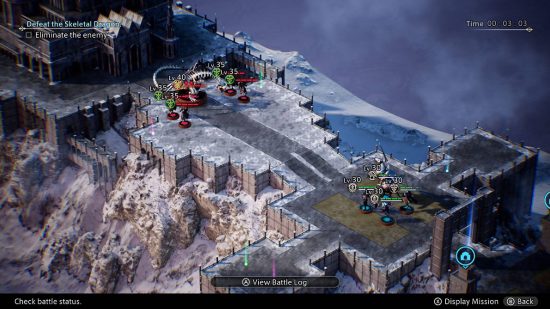
Balancing the main four characters is key, as the different enemy units will demand a mixture of lances, swords, arrows, magic, and obviously a healer there in case things go wrong. The main four characters cover a lot of this, with the lead cast including wonderfully named folks like Fredret Lester, Iscarion Colchester, Waltaquin Redditch, and an archer called Rickenback who everyone affectionately calls Rickles. Most of the story is told through the eyes of this troop of characters called the Blue Foxes, and its enigmatic leader, the assassin known as Andrias Rhondarson.
The cast of characters is very well written, and I quickly found myself enamoured with several of them, thoroughly enjoying the well-voice-acted cut scenes between missions and the smaller bits of written dialogue littered between. There’s a lot of talking to get through, but I’d expect nothing less from a high-fantasy game steeped in political intrigue. Importantly, most of the dialogue is interesting, entertaining, or at the very least leaves breadcrumbs for the mysteries of the world. It can be very easy to get bored and skip through this sort of stuff, but I highly recommend taking your time and enjoy listening to what everyone had to say.
Early on you unlock a base of operations that you can explore between missions, not unlike the school from Fire Emblem: Three Houses, and a lot of the fun NPC dialogue is scattered around here. Characters represent different vendors, and you have the ability to buy or develop new weapons, increase the level of your Magilumic Orbs, and a few other important additions to your arsenal. There are a lot of systems to keep on top of, but I thoroughly enjoy taking stock between each mission and increasing my stats or adding to my equipment.
Personally, this stuff works for me, as I love the slow creep of using the resources you earn in battle and gently increasing the effectiveness of my team, but I can see it being overwhelming for some, as there are a huge amount of options to keep on top of. Also, while you unlock a set amount of gold for each successful mission, some resources are gated behind win conditions like completing a level without any characters dying, or managing to complete one in under four minutes.
It seems that levels are designed to be rewound to unlock all the available items, and thankfully, there are a few things here to make it easier. At any point during a mission, you can choose to restart from any of the checkpoints (usually when a new batch of enemies drops in), and you can increase the battle speed up to 2x. While I didn’t often speed up battles on my first try as it meant I was often too easily overwhelmed, mopping up the optional side missions was an easy way to get extra resources. I haven’t seen any option to replay levels yet, as the story seems to just keep moving, but I hope I can eventually go back to earlier missions, or at least go through again on new game plus.
Finally, it’s important to talk about the look of the game, as this is a multiplatform release, so the Switch version is competing with more powerful consoles here. While concessions have clearly been made, I’d have to say that The Diofield Chronicle is a beautiful game, with gorgeous character design and clearly laid-out levels that make smart use of the Switch’s capabilities. The battles look good as the diorama-like levels have an impressive amount of detail and foliage (though textures can look muddy, and the action runs smoothly, though you will find some frame dips when you speed up the action and use the more taxing special moves.
Similarly, the communal area you explore between missions looks lovely, and while again there’s the odd frame dip, it seems Square has prioritised visual clarity in the moments where framerate isn’t as important. There are also well-directed cut-scenes as you progress the story, and these look fantastic, making use of the dark and ominous atmosphere of a surprisingly morbid story at times, but bringing in streaks of bright colour with the many magical elements. Things can look a tad compressed as the cut scenes are clearly the same as the ones running on more powerful hardware, but they look great all the same.

Altogether, so far, The Diofield Chronicle has surprised me with its RTTB system and impressive attention to detail in its world-building, dialogue, and rich characters. I can’t wait to get further into the story, and each battle is a tense struggle where every single moment counts. It definitely sets itself apart in gameplay, but while I enjoy its world I do worry that it doesn’t do enough to stand out from the pack in the saturated market of fantasy SRPG titles now on the Switch. If you only buy one strategy game this year, I’d likely still tell you to buy Triangle Strategy, but if you’re a diehard fan of the strategy genre looking for a test and a world full of interesting systems and areas to explore, The Diofield Chronicle is an impressive, challenging, and addictive game with so much to offer.
